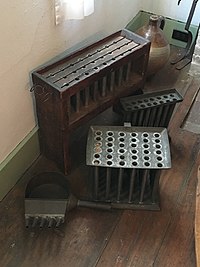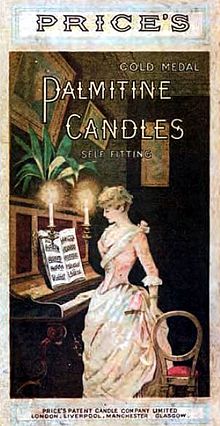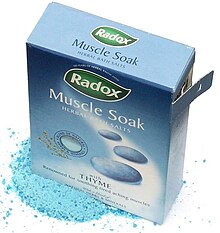Middle Ages

The oldest surviving bees wax candles north of the Alps from the alamannic graveyard of Oberflacht, Germany dating to 6th/7th century A.D.
After the collapse of the
Roman empire, trading disruptions made
olive oil, the most common fuel for oil lamps, unavailable throughout much of Europe. As a consequence, candles became more widely used. By contrast, in
North Africa and the
Middle East, candle-making remained relatively unknown due to the availability of olive oil.
Candles were commonplace throughout Europe in the
Middle Ages. Candle makers (known as
chandlers) made candles from fats saved from the kitchen or sold their own candles from within their shops. The trade of the chandler is also recorded by the more picturesque name of "smeremongere", since they oversaw the manufacture of sauces, vinegar, soap and cheese. The popularity of candles is shown by their use in
Candlemas and in
Saint Lucy festivities.
Tallow, fat from cows or sheep, became the standard material used in candles in Europe. The unpleasant smell of tallow candles is due to the
glycerine they contain. The smell of the manufacturing process was so unpleasant that it was banned by ordinance in several European cities.
Beeswax was discovered to be an excellent substance for candle production without the unpleasant odor, but remained restricted in usage for the rich and for churches and royal events, due to their great expense.
Modern era

'Colonial'-style tapered candle molds
With the growth of the
whaling industry in the 18th century,
spermaceti, an oil that comes from a cavity in the head of the
sperm whale, became a widely used substance for candle making. The spermaceti was obtained by crystallizing the oil from the sperm whale and was the first candle substance to become available in mass quantities. Like beeswax, spermaceti wax did not create a repugnant odor when burned, and produced a significantly brighter light. It was also harder than either tallow or beeswax, so it would not soften or bend in the summer heat. The first "standard candles" were made from spermaceti wax.
Industrialization

Joseph Morgan's candle making machine revolutionized candle making
The manufacture of candles became an industrialized mass market in the mid 19th century. In 1834, Joseph Morgan, a pewterer from
Manchester, England, patented a machine that revolutionised candle making. It allowed for continuous production of molded candles by using a cylinder with a moveable piston to eject candles as they solidified. This more efficient mechanized production produced about 1,500 candles per hour, (according to his patent ". . with three men and five boys [the machine] will manufacture two tons of candle in twelve hours"). This allowed candles to become an easily affordable commodity for the masses.

Price's Candles became the largest candle manufacturer in the world by the end of the 19th century
At this time, candlemakers also began to fashion wicks out of tightly
braided (rather than simply twisted) strands of
cotton. This technique makes wicks curl over as they burn, maintaining the height of the wick and therefore the flame. Because much of the excess wick is incinerated, these are referred to as "self-trimming" or "self-consuming" wicks.
Paraffin could be used to make inexpensive candles of high quality. It was a bluish-white wax, burned cleanly, and left no unpleasant odor, unlike
tallow candles. A drawback to the substance was that early coal- and petroleum-derived paraffin waxes had a very low melting point. The introduction of
stearin, discovered by
Michel Eugène Chevreul, solved this problem. Stearin is hard and durable, with a convenient melting range of 54–72.5 °C (129.2–162.5 °F). By the end of the 19th century, most candles being manufactured consisted of paraffin and stearic acid.
By the late 19th century,
Price's Candles, based in London was the largest candle manufacturer in the world. The company traced its origins back to 1829, when William Wilson invested in 1,000 acres (4 km²) of coconut plantation in
Sri Lanka. His aim was to make candles from coconut oil. Later he tried palm oil from palm trees. An accidental discovery swept all his ambitions aside when his son George Wilson, a talented chemist, distilled the first petroleum oil in 1854. George also pioneered the implementation of the technique of steam distillation, and was thus able to manufacture candles from a wide range of raw materials, including skin fat, bone fat, fish oil and industrial greases.
Decline of the candle industry

Candles here are used to celebrate a birthday
Despite advances in candle making, the candle industry declined rapidly upon the introduction of superior methods of lighting, including
kerosene and
lamps and the 1879 invention of the
incandescent light bulb.
From this point on, candles came to be marketed as more of a decorative item. Candles became available in a broad array of sizes, shapes and colors, and consumer interest in scented candles began to grow. During the 1990s, new types of candle waxes were being developed due to an unusually high demand for candles. Paraffin, a by-product of oil, was quickly replaced by new waxes and wax blends due to rising costs.
Candle manufacturers looked at waxes such as soy, palm and flax-seed oil, often blending them with paraffin in hopes of getting the performance of paraffin with the price benefits of the other waxes. The creation of unique wax blends, now requiring different fragrance chemistries and loads, placed pressure for innovation on the candle wick manufacturing industry to meet performance needs with the often tougher to burn formulations.
Hand operated, water cooled, candle making machines
-
12" Candles wound out from hand operated machine
for

Workers packing candles into shipping boxes
-










